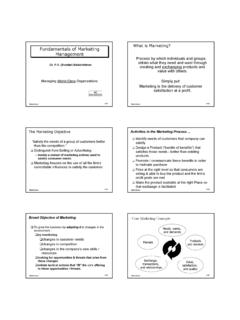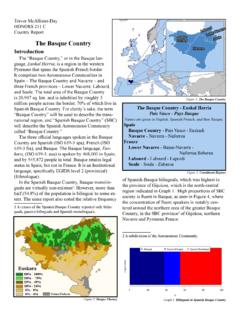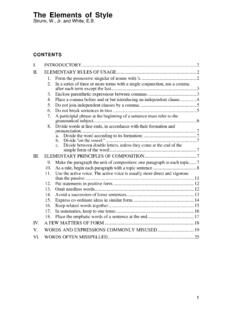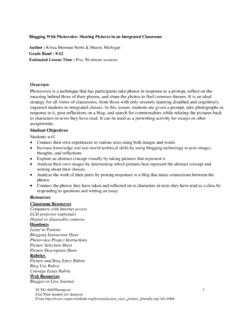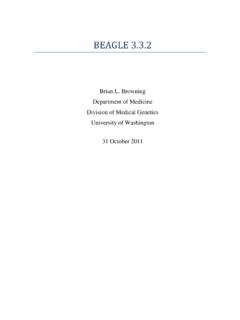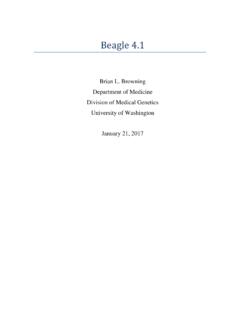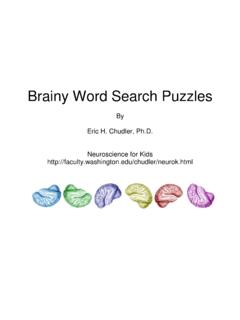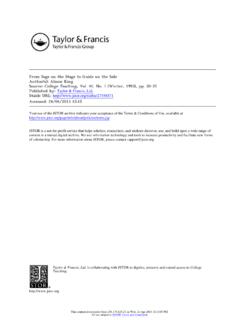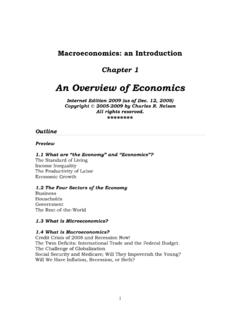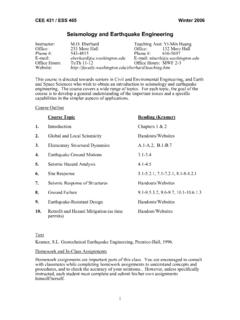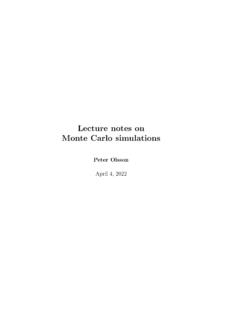Transcription of Bayesian Statistics (a very brief introduction)
1 Bayesian Statistics ( a very brief introduction ). Ken Rice Epi 516, Biost 520. , T478, April 4, 2018. Overview Rather than trying to cram a PhD's- worth of material into 90 What is Bayes' Rule, Bayes' Theorem? What is Bayesian inference? Where can Bayesian inference be helpful? How, if at all, is it different to frequentist inference? Note: the literature contains many pro- and anti- Bayesian polemics, many of which are ill-informed and unhelpful. I will try not to rant, and aim to be accurate. Further Note: There will, unavoidably, be some discussion of epistemology, philosophy concerned with the nature and scope of knowledge. 1. Overview Using a spade for some jobs and shovel for others does not require you to sign up to a lifetime of using only Spadian or Shovelist philos- ophy, or to believing that only spades or only shovels represent the One True Path to garden neatness.
2 There are different ways of tackling statistical problems, too. 2. Bayes' Theorem Before we get to inference: Bayes' Theorem is a result in conditional probability, stating that for two events A and P[ A and B ] P[ A ]. P[ A|B ] = = P[ B|A ] . P[ B ] P[ B ]. In this example;. 1/10. P[ A|B ] = 3/10 = 1/3. 1/10. P[ B|A ] = 5/10 = 1/5. 5/10. And 1/3 = 1/5 3/10 (X). In words: the conditional probability of A given B is the conditional probability of B given A scaled by the relative probability of A compared to B. 3. Bayes' Theorem Why does it matter? If 1% of a population have cancer, for a screening test with 80% sensitivity and 95% specificity;. Test Positive P[ Test +ve|Cancer ] = 80%. Have Cancer P[ Test +ve]. = P[ Cancer ]. P[ Cancer|Test +ve ] 14%.. most positive results are actually false alarms Mixing up P[ A|B ] with P[ B|A ] is the Prosecutor's Fallacy; a small probability of evidence given innocence need NOT mean a small probability of innocence given evidence.
3 4. Bayes' Theorem: Sally Clark After the sudden death of two baby sons, Sally Clark (above, center) was sentenced to life in prison in 1999. Among other errors, expert witness Prof Roy Meadow (above right) had wrongly interpreted the small probability of two cot deaths as a small probability of Clark's innocence After a long campaign, including refutation of Meadow's Statistics , Clark was released and cleared in 2003. After being freed, she developed alcoholism and died in 2007. 5. Bayes' Theorem: XKCD at the beach This is roughly equal to # of times I've picked up a seashell at the ocean , # of times I've picked up a seashell ..which in my case is pretty close to 1, and gets much closer if we're considering only times I. didn't put it to my ear. 6. Bayes' Theorem Bayes' theorem also applies to continuous variables say systolic and diastolic blood pressure.
4 The conditional densities of the random variables are related this way;. f (x). f (x|y) = f (y|x). f (y)..which we can write as f (x|y) f (y|x)f (x). This proportionality statement is just a re-wording of Bayes'. Theorem. Note: Like probabilities, densities are 0, and add up to 1'. 7. Bayesian inference So far, nothing's controversial; Bayes' Theorem is a rule about the language' of probabilities, that can be used in any analysis describing random variables, any data analysis. Q. So why all the fuss? A. Bayesian inference uses more than just Bayes' Theorem In addition to describing random variables, Bayesian inference uses the language' of probability to describe what is known about parameters. Note: Frequentist inference, using p-values & confidence intervals, does not quantify what is known about parameters.
5 *many people initially think it does; an important job for instructors of intro Stat/Biostat courses is convincing those people that they are wrong. 8. Freq'ist inference (I know, shoot me!). Frequentist inference, set all a-quiver;. Adapted from Gonick & Smith, The Cartoon Guide to Statistics 9. Freq'ist inference (I know, shoot me!). Frequentist inference, set all a-quiver;. We trap' the truth with 95% confidence. Q. 95% of what? 10. Freq'ist inference (I know, shoot me!). The interval traps the truth in 95% of experiments. To define anything frequentist, you have to imagine repeated experiments. 11. Freq'ist inference (I know, shoot me!). Let's do some more target practice', for frequentist testing;. 12. Freq'ist inference (I know, shoot me!). Let's do some more target practice', for frequentist testing.
6 13. Freq'ist inference (I know, shoot me!). Let's do some more target practice', for frequentist testing;. 14. Freq'ist inference (I know, shoot me!). Let's do some more target practice', for frequentist testing;. 15. Freq'ist inference (I know, shoot me!). For testing or estimating, imagine running your experiment again and again. Or, perhaps, make an argument like this;. On day 1 you collect data and construct a [valid] 95% confidence interval for a parameter 1. On day 2 you collect new data and construct a 95% confidence interval for an unrelated parameter 2. On day 3 .. [the same]. You continue this way constructing confidence intervals for a sequence of unrelated parameters 1, 2, .. 95% of your intervals will trap the true parameter value Larry Wasserman, All of Statistics This alternative interpretation is also valid.
7 Neither version says anything about whether your data is in the 95% or the 5%.. both versions require you to think about many other datasets, not just the one you have to analyze How does Bayesian inference differ? Let's take 16. Bayesian inference [Appalling archery pun goes here]. 17. Bayesian inference [Appalling archery pun goes here]. 18. Bayesian inference [Appalling archery pun goes here]. 19. Bayesian inference [Appalling archery pun goes here]. 20. Bayesian inference [Appalling archery pun goes here]. 21. Bayesian inference Here's exactly the same idea, in practice;. During the search for Air France 447, from 2009-2011, knowledge about the black box location was described via probability using Bayesian inference Eventually, the black box was found in the red area 22.
8 Bayesian inference How to update knowledge, as data is obtained? We use;. Prior distribution: what you know about parameter , excluding the information in the data denoted ( ). Likelihood: based on modeling assumptions, how [relatively]. likely the data Y are if the truth is denoted f (Y| ). So how to get a posterior distribution: stating what we know |Y)? about , combining the prior with the data denoted p( . Bayes Theorem used for inference tells us to multiply;. |Y) f (Y| . p( ) ( . ). Posterior Likelihood Prior.. and that's it! (essentially!). No replications no replicate plane searches Given modeling assumptions & prior, process is automatic Keep adding data, and updating knowledge, as data becomes knowledge will concentrate around true . 23. Bayesian inference Bayesian inference can be made, er, transparent.
9 Common sense reduced to computation Pierre-Simon, marquis de Laplace (1749 1827). Inventor of Bayesian inference 24. Bayesian inference The same example; recall posterior prior likelihood;. prior likelihood 5. posterior 4. Probability density 3. 2. 1. 0. Parameter A Bayesian is one who, vaguely expecting a horse, and catching a glimpse of a donkey, strongly believes he has seen a mule Stephen Senn, Statistician & Bayesian Skeptic (mostly). 25. But where do priors come from? An important day at statistician-school? There's nothing wrong, dirty, unnatural or even unusual about making assumptions carefully. Scientists & statisticians all make even if they don't like to talk about them. 26. But where do priors come from? Priors come from all data ex- ternal to the current study, everything else.
10 Boiling down' what subject- matter experts know/think is known as eliciting a prior. It's not easy (see right) but here are some simple tips;. Discuss parameters experts understand code variables so intercept is mean outcome in people with average covari- ates, not with age=height=IQ=0. Avoid leading questions (just as in survey design). The language' of probability is unfamiliar; help users express their uncertainty Kynn (2008, JRSSA) is a good review, describing many pitfalls. 27. But where do priors come from? Ideas to help experts translate' to the language of probability;. Use 20 5% stickers (Johnson et Normalize marks (Latthe et al al 2010, J Clin Epi) for prior on 2005, J Obs Gync) for prior on survival when taking warfarin pain effect of LUNA vs placebo Typically these coarse' priors are smoothed.
